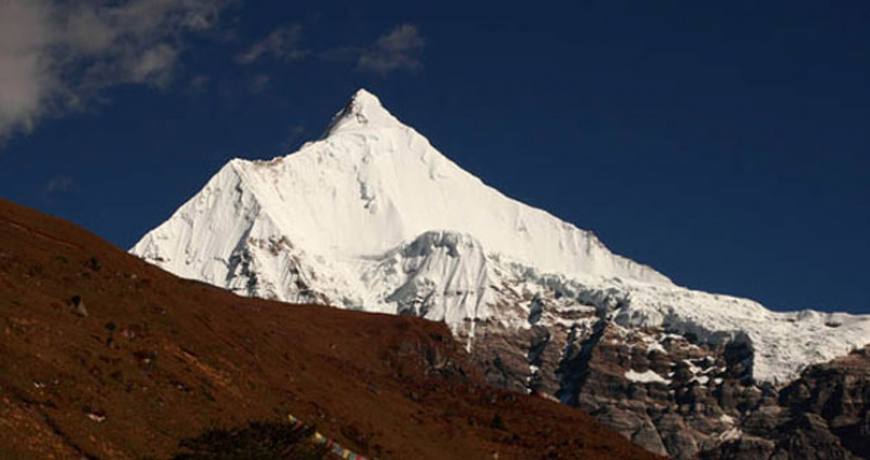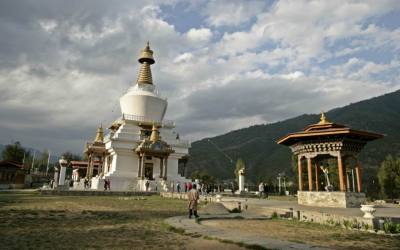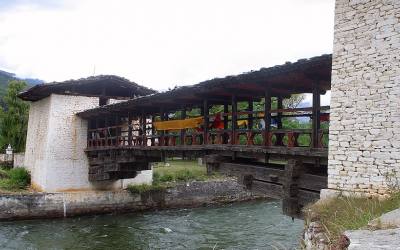This is without doubt one of the most beautiful and unspoilt trekking areas in the entire Himalayas.The trip begins in Paro, gateway to Bhutan and set in a wide valley dotted with traditional dwellings and terraced farms, watched over by the great Paro Dzong (monastery Fort). From here you head up valley where the trek begins. You will follow the waters of the Paro chu river up through forests of pine and juniper and into high alpine meadows for stunning views of Mt. Chomolhari (7316m) and Jichu Drake (6797m). This is wild country and its quite possible that you will see the rare blue sheep or bharal. From here the trek heads north-east to the village of Lingshi (3800m). The Lingshi Dzong is over 600 years old. It was built by a Lama for purely monastic purposes but due to its strategic position it soon became one of the strong holds against invading Tibetan armies.
From Lingshi you then head down along ancient trails and through un-touched forests to reach Thimphu, Bhutan’s tiny capital and the concluding point for the trek. There will be time here to see the sights, notably to massive and imposing Tashichho Dzong. Bhutan’s seat of power. Then you will return to Paro where the trip concludes.
Day 01: Arrival and transfer to hotel in kathmandu
Day 02: sight seeing around kathmandu valley with English speaking guide
Day 03: Fly to paro
Day 04: Paro sight seeing
Day 05: Paro - Shana ( start of trek)
Day 06: Shana – Thangthangka
Day07:Thangthangka – Jangothang:
Day 08:Jangothang: Rest day at Jangothang,
Day 09. Jangothang – Lingshi:
Day 10. Lingshi – Shodu: 8 hrs walk.
Day 11. Shodu – Barshong:
Day 12. Barshong – Dolamkencho:
Day 13. Dolamkencho – Dodena – Thimphu:
Day 14. Thimphu sightseeing:
Day 15. Thimphu- Punakha - Thimphu: (72 Kms, 2 hours drive)
Day16 : Drive to Paro airport for the connecting flight to Kathmandu
Day17: Sight seeing tour to Bhaktapur city and Changu Narayan temple
Day18: Tour Ends ( Departure onwards)
Day01: Arrival and transfer to Hotel in Kathmandu
Upon arrival in Kathmandu. Our airport representative will be waiting outside the airport terminal a few metres from the exit door. Please check your name at play card. He will bring you to hotel in kathmandu. The drive from the airport to the hotel is around 20 minutes.
Day02: Free day in Kathmandu or sight seeing around kathmandu valley with English speaking guide.
Hanumandhoka ( Kathamdnu Durbar Square ):
It is the historic seat of royalty. The Durbar Square , with its old temples and palaces, epitomizes the religious and cultural life of people. It is here that kings of Nepal are crowned and their coronations solemnized. Interesting things to see here are, Taleju temple built by king Mahendra Malla in 1954 AD, the temple of Kal Bhairab , the god of destruction, Nautale durbar, the statue of King Pratap Malla, the big drum and the Jaganath temple. It was listed in the UNESCO world heritage monument list in 1979.
On the right hand corner, a large wooden lattice screen hides an enormous gilded face of Sweta Bhairab. The screen is removed only during the Indra Jatra festival.. there are also the Numismatic museum and Tribhuban museum inside the Hanuman Dhoka palace building . Photography is prohibited inside the museums. Both the mseums remain closed on Tuesday and government holidays.
Swoyambhunath ( Monkey temple)
This is one of the world’s most glorious Buddhist Chaityas. It is said to be 2,000 years old. Painted on the four sides of the spire’s base are the all seeing eyes of Lord Budhha. It is 3Km west of Kathmandu city and it situated on a hillock about 77 m commands an excellent view of the Valley. This stupa is the oldest of its kind in Nepal . It was listed in the UNSCO world Heritage Monument List in 1979.
Boudhanath stupa
Boudhanath Stupa (or Bodnath Stupa) is the largest stupa in Nepal and the
holiest Tibetan Buddhist temple outside Tibet . It is the center of Tibetan
culture in Kathmandu and rich in Buddhist symbolism. The stupa is located in
the town of Boudha , on the eastern outskirts of Kathmandu .
History
Bodnath was probably built in the 14th century after the Mughal invasions;
various interesting legends are told regarding the reasons for its construction. After the arrival of thousands of Tibetans following the 1959 Chinese invasion, the temple has become one of the most important centers of Tibetan Buddhism. Today it remains an important place of pilgrimage and meditation for Tibetan Buddhists and local Nepalis, as well as a popular tourist site.
Pashupatinath Temple :
Situated 5km east of kathamandu, the temple of Lord Shiva , Pashupatinath, with two tired golden roof and silver door is considered one of the holiest for Hindus. Although only Hindus are allowed inside the temple, visitors can clearly see the temple and the activites performed in the Temple premises from the eastern bank of the Bagmati river. The Temple was listed in the UNESCO world heritage Monument List in 1979
Jumolhari Trek 2 (Round Trek)
It is a classic 9-day Trek starting from (Drugyal Dzong) Paro and end at Dodena near Thimphu. The route passes through two high passes from Jangothang. The view of Jumolhari Mountain (7314 M) from Jangothang is spectacular. The Trek is strenuous and is very popular. The highest point is 4115 M.
Day 03. Arrival at Paro: Upon arrival at Paro airport, received by representative from our company, transfer to the hotel. Dinner and overnight at the hotel in Paro.
Day 04. Paro sightseeing: After breakfast, drive to the ruins of Drukgyel dzong, now in ruins was built by Shabdrung Ngawang Namgyal to commemorate the victory over the Tibetan invaders in1644; the dzong name’s means indeed “ victorious Druk “. The Dzong was used as an administrative center until 1951 when a fire caused by butter lamp destroyed it. Then visit Kyichu Lhakhang, one of Bhutan’s oldest and most sacred monasteries dating from the introduction of Buddhism in the 8th century and then visit Rimpung Dzong (Paro Dzong) built in 1646 by Shabdrung Ngawang Namgyal. The Dzong presently houses administrative offices. After lunch visit the Ta dzong, an ancient watchtower, which has been, since 1967, the national museum of Bhutan. Dinner and overnight at the hotel in Paro.
Day 05. Paro – Shana (Start of Trek): Our trek to Shana starts at Drukgyal Dzong following the Paro river and we pass cultivated fields and tiny picturesque villages. The forests are alive with numerous birds and brightly coloured butterflies. Overnight at camp Shana. Altitude 2,820 m; Distance 14 Km; Time 5 - 6 hours.
Day 06. Shana – Thangthangka: The trail follows the river through a heavily forested area with a few isolated farmhouses. It narrows and closes in and the trail winds up and down along the drainage. We pass a junction enroute, where another path leads north over the Tremo La to Tibet. Camp is in a meadow with a stone shelter. Altitude 3610 m; Distance 21 Km; Time 7 - 8 hours.
Day 07. Thangthangka – Jangothang: In the morning after passing a small army post, the trail slowly leaves the forest line and gradually climbs into a beautiful valley, passing Tegethang, a winter home of yak herdsmen. Lunch will be served in one of these huts. Lots of yaks will be seen today before we arrive at the Jhomolhari base camp (4,115 m). High mountains overlook the camp and visible nearby are the ruins of an old fortress used to guard Bhutan against Tibetan invasions. Altitude 4,115 m; Distance 15 Km; Time 5 - 6 hours.
Day 08. Jangothang: Rest day at Jangothang, enjoy the superb view all around.
Day 09. Jangothang – Lingshi: The trail follows the stream for half an hour and crosses the bridge to the right side. Start the climb up to the first ridge with a breathtaking view of Jumolhari, JichuDrakey and Tsrim Ghang. Then walk towards the valley, almost flat for a while, until the climb to the Nyeley la pass at an altitude of 4,700 meters. After the pass it’s a gradual descent to the Lingshi camp, enjoying the panorama view of the peaks and Lingshi dzong. Camp altitude is 4000 meters. Walking time 7-8 hours.
Day 10. Lingshi – Shodu: 8 hrs walk. The trail today climbs to Yalila Pass (4820 m), from where on a clear day, impressive views of Mount Jumolhari, Tserim Kang and Masagang can be seen.
Day 11. Shodu – Barshong: This is the place where one comes back to the tree line. The path follows the Thimphu River, descending through rhododendron, juniper and other alpine forest. The view of the cliff facing rocks and waterfalls are stunning. Hot lunch will be served by the riverside. After lunch the trail gradually ascends to the ruins of the Barshong dzong, reaching the camp at the altitude 3600meters. Walking time 6-7 hours.
Day 12. Barshong – Dolamkencho: The road descends through alpine forest and we once again join Thimphu river for a while. After lunch climb up to Dolamkencho camp at the altitude of 3600meters. Walking time 5-6 hours.
Day 13. Dolamkencho – Dodena – Thimphu: The path descends through bamboo forests finally joining Thimphu River again. Arrive at Dodena where you will be picked up for the drive to Thimphu (15 km) 4 hours walk. Overnight at the hotel.
Day 14. Thimphu sightseeing: The day begins with a visit to the National Memorial Chorten (1974) built in honour of our late King Jigme Dorji Wangchuk and the Dupthop Lhakhang one of the few surviving nunneries in Bhutan. We then visit the National Library, stocked with ancient Buddhist manuscripts, and the Painting School where traditional art is still kept alive through instructions in the art of painting Thangkas (sacred Buddhist religious scrolls). After lunch we drive to the Traditional Medicine Institute where medicines are prepared according to ancient practices, and to Lungtenzampa to observe the Royal silver smiths and Bhutanese paper factory at work. Other highlights include a visit to the Tashichho Dzong, seat of the national government and the Central Monastic Body, including the summer residence of the Je Khenpo (Chief Abbot of Bhutan). The Tashichho Dzong is open to visitors only in winter when the Je Khenpo and the Monk Body move to Punakha the ancient winter capital of Bhutan. We drive to Simtokha Dzong; the oldest Dzong of Bhutan built by Shabdrung in 1627 and finally visit the Handicrafts Emporium followed by shopping for souvenirs in the shops of Thimphu. Over night in Hotel.
Day 15. Thimphu- Punakha - Thimphu: (72 Kms, 2 hours drive). After breakfast, Drive to Punakha via Dochula pass. If the weather is clear, we stop for a while at Dochula pass to view Higher Himalayas. Lunch at Punakha. After lunch, visit Punakha Dzong built in 1637 by Shabdrung Ngawang Namgyal and is situated between Pho Chu (Male river) and Mo Chu (Female river). For many years until the time of the second king, it served as the seat of the Government. The construction of the Dzong was foretold by Guru Rimpoche, who predicted, “…a person named Namgyal will arrive at a hill that looks like an elephant”. There was a smaller building here called Dzong Chu (Small Dzong) that housed a statue of Buddha. It is said that Shabdrung ordered the architect, Zowe Palep, to sleep in front of the statue, while Palep was sleeping, the Shabdrung took him in his dreams to Zangtopelri and showed him the palace of Guru Rimpoche. From his vision, the architect conceived the design for the new Dzong, which in keeping with the tradition, was never committed to paper. The Dzong was named Druk Pungthang Dechen Phodrang (Palace of Great Happiness). The war materials captured during the battle with Tibetans are preserved here. Punakha is still the winter residence of Je-Khenpo and King Jigme Dorji Wangchuk convened the new national Assembly here in 1952. In the evening, drive back to Thimphu. Overnight in Hotel.
Day16 : Drive to Paro airport for the connecting flight to Kathmandu. During the afternoon sight seeing around Patan.
Patan
The ancient city of Patan , lying 5 km southwest of kathmandu, is known as the city of fine arts, The city is full of Hindu temples and Buddhist
monuments. The diversity of the medieval culture that allowed both Hinduism and Buddhism to flourish has left a rich legacy of impressive sightseeing in this city for today’s visitors.
Patan Durbar Square:
Situated in the heart of the city, constitutes the focus of visitor’s
attraction. The square is full of ancient palaces, Temple and shrines, noted for their exquisite carvings. The Patan durbar Square consist of three main chowks or countryards, the Central Mul Chowk, Sundari Chowk and Keshar narayan Chowk, The Sundari Chowk holds in its center a masterpiece of stone architecture. The Royal Bath called Tushahity. It was listed in the UNESCO world HeritageMonument list in 1979.
Krishna Mandir:
Built in 1637 AD, the temple of Lord Krishaa holds a commanding position in the palace complex of Patan. It is supposed to be the first specimen of Shikhara style architecture in Nepal . It is the only temple in Nepal having 21 spires and is completely 21 spires and is completely mad of stone.
Day17: Sight seeing tour to Bhaktapur city and Changu Narayan temple
Bhaktapur durbar Squares:
The Golden Gate is the entrance to the main courtyard of the Palace of 55 Windows.Built by King Ranjit Malla. The gate is one of the most beautiful and richly carved specimens of its kind in the entire world. This gate is embellished with deities and monsters with marvelous intricacy. The palace of 55 windows was built in 1700 AD. Among the brick walls in their gracious setting and sculptural design, is a balcony of 55 windows. This balcony is a masterpiece of wood carving. The stone temple of Batsala Devi which is also located in the Durbar Square is full of intricate carvings. This temple also sets a beautiful example of Shikhara style architecture in Nepal. There is a bronze bell on the terrace of the temple which is also known as the Bell of Barking Dogs.
This colossal bell, placed in 1737 AD, was rung to signal curfew those days.
The main square of the city contains innumerable temples and other architectural showpieces like the Lion Gate, the statue of King Bhupatindra Malla, the Picture Galley, the Batsal Temple, etc. A magnificent statue of King Bhupatindra Malla in the act of worship is placed on the column facing the palace. It was listed in the UNESCO World Heritage Monument list in 1979.
Changu Narayan:
Situated at the end of a long ridge which runs well into the Valley, It is said to have been built by king Hari Dutta in 323 AD said to be the oldest temple in the valley. It was listed in the UNESCO world Heritage Mountain list in 1979
Day18: Tour Ends ( Departure onwards)
What’s Included
- All Meals [Breakfast /Lunch/Dinner]
- Accommodation [Twin Sharing] Single Room Supplement Extra US $: 40 per room per night.
- All transportation within the country including airport transfers.
- Royalty & Govt. Taxes
- Entrance fees for Museums and Monuments only
- Visa Fee.
- Airport tax
- Tourism Development fund
- Guide.
- Sightseeing
What’s not Included
- Druk Air fare.
- Insurance Premiums,
- Payments for service provided on a personal basis
- Cost for any services not mentioned in the "Cost Include head"
- Cost incurred due to mishaps, strikes, political unrest etc.
- Personal expense in items such as laundry, soft drinks, Camera Charges, Bottle water, incidentals, Portage, Bellboy charges tips or any other services.


